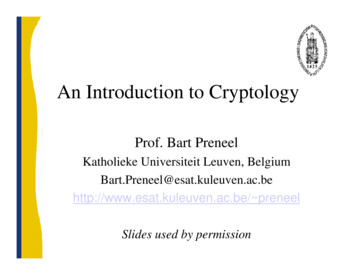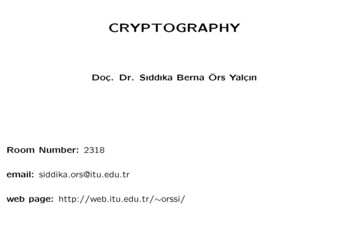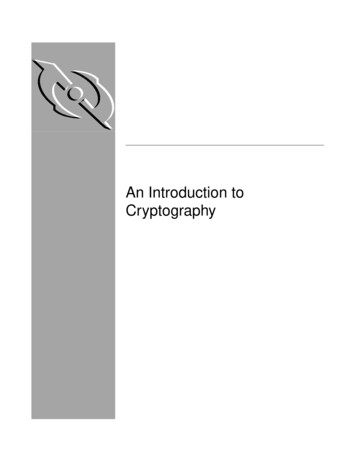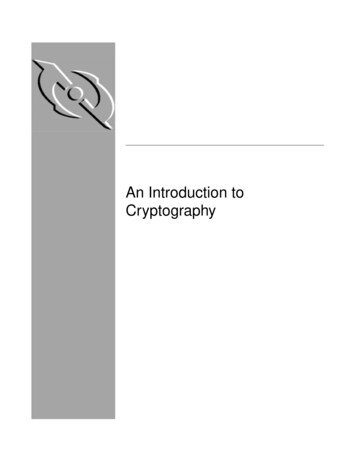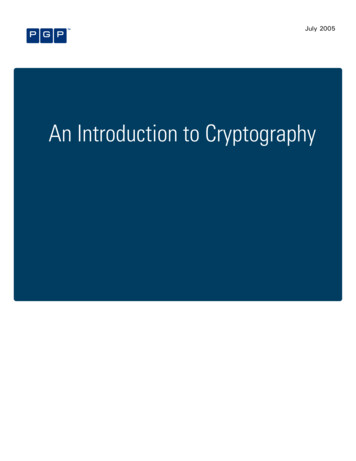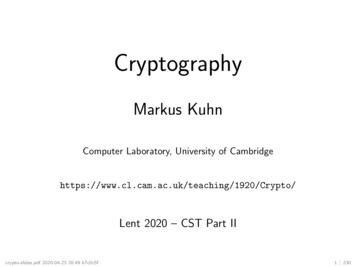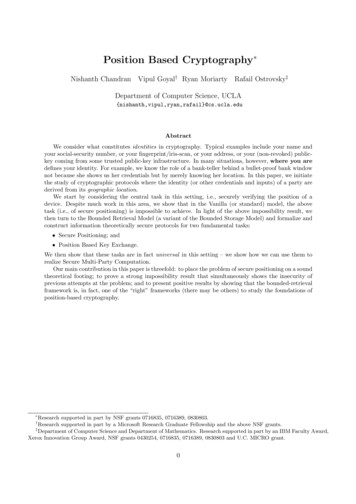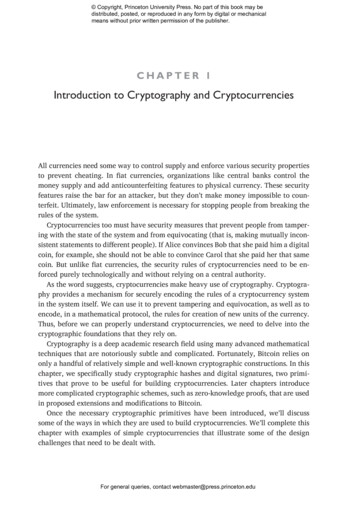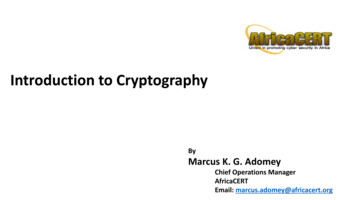
Transcription
CryptographyWinter term 2004/05 byProf. Dr. Joachim Rosenthal,University of ZürichFor personal use onlyFelix FonteinMarch 8, 2005
Contents1 Cryptography1.1 Road Map to Cryptography . . . . . . . . . . . . . . . . . . . .1.2 Introduction to Secret Key Systems . . . . . . . . . . . . . . .1.3 One-way Trapdoor Functions and the RSA System . . . . . . .1.4 A Small Background in Complexity Theory . . . . . . . . . . .1.5 Finding Primes and Primality Checking . . . . . . . . . . . . .1.5.1 The Fermat Test . . . . . . . . . . . . . . . . . . . . . .1.5.2 The Solovay-Strassen Test (1977) . . . . . . . . . . . . .1.5.3 The Miller-Rabin Test . . . . . . . . . . . . . . . . . . .1.5.4 Deterministic Primality Tests . . . . . . . . . . . . . . .1.6 Finite Fields . . . . . . . . . . . . . . . . . . . . . . . . . . . .1.7 Security Issues of RSA . . . . . . . . . . . . . . . . . . . . . . .1.7.1 Implementation Weaknesses . . . . . . . . . . . . . . . .Distance of p and q . . . . . . . . . . . . . . . . . . . . .Pollards (p 1) Factoring Attack . . . . . . . . . . . . .Common Modulus Attack . . . . . . . . . . . . . . . . .Short Message Encryption . . . . . . . . . . . . . . . . .Bleichenbacher Attack . . . . . . . . . . . . . . . . . . .Low Public Key . . . . . . . . . . . . . . . . . . . . . .Low Private Key Exponent . . . . . . . . . . . . . . . .1.7.2 Some Quick Notes on Factoring . . . . . . . . . . . . . .1.8 Secret Key Ciphers . . . . . . . . . . . . . . . . . . . . . . . . .1.8.1 Stream Ciphers . . . . . . . . . . . . . . . . . . . . . . .1.8.2 Block Ciphers . . . . . . . . . . . . . . . . . . . . . . . .1.9 Public Key Systems Based on the Discrete Logarithm Problem1.9.1 Solving the Discrete Logarithm Problem . . . . . . . . .Exhaustive Search . . . . . . . . . . . . . . . . . . . . .Baby-step Giant-step . . . . . . . . . . . . . . . . . . . .Pohlig-Hellmann . . . . . . . . . . . . . . . . . . . . . .Index Calculus . . . . . . . . . . . . . . . . . . . . . . .Pollard ρ Method . . . . . . . . . . . . . . . . . . . . . .1.10 An Introduction to Elliptic Curves . . . . . . . . . . . . . . . .1.10.1 Affine Curves . . . . . . . . . . . . . . . . . . . . . . . .1.10.2 Bezóut’s Theorem for Curves . . . . . . . . . . . . . . .1.10.3 Projective Plane . . . . . . . . . . . . . . . . . . . . . .1.10.4 Elliptic Curves . . . . . . . . . . . . . . . . . . . . . . .1.10.5 The group law . . . . . . . . . . . . . . . . . . . . . . .1.10.6 Determining the Group Order . . . . . . . . . . . . . . .Shanks-Mestre Algorithm . . . . . . . . . . . . . . . . .1.10.7 General Algorithms to Solve the ECDLP . . . . . . . .Baby-step Giant-step . . . . . . . . . . . . . . . . . . . .Pohlig-Hellmann . . . . . . . . . . . . . . . . . . . . . .Pollard ρ and λ Method . . . . . . . . . . . . . . . . . .1.10.8 Divisors and the Weil Pairing . . . . . . . . . . . . . . .1.11 Alternative Public-Key Systems . . . . . . . . . . . . . . . . . .1.11.1 Rabin System (1981) . . . . . . . . . . . . . . . . . . . .1.11.2 The Merkle-Hellman Knapsack System . . . . . . . . . 35353535363840404040424446464848484849555556
iiiCONTENTS1.121.131.141.151.11.3 Polly-Cracker . . . . . . . . . . . . . . . . . . . . . . .1.11.4 McEliece Crypto System (1978) . . . . . . . . . . . . .1.11.4.1 A Small Background in Coding Theory . . .1.11.4.2 The McEliece System . . . . . . . . . . . . .1.11.5 One-Way Trapdoor Functions from Semigroup ActionsLattices and the LLL Algorithm . . . . . . . . . . . . . . . .Factoring . . . . . . . . . . . . . . . . . . . . . . . . . . . . .1.13.1 The Quadratic Sieve . . . . . . . . . . . . . . . . . . .1.13.2 The Factorization Method of Claus Schnorr (1993) . .1.13.3 Lenstras Elliptic Curve Factorization Method . . . . .Hash Functions . . . . . . . . . . . . . . . . . . . . . . . . . .1.14.1 The Chaum-van Heijst-Pfitzmann Hash Function . . .1.14.2 Construction of Practical Hash Functions . . . . . . .Protocols . . . . . . . . . . . . . . . . . . . . . . . . . . . . .1.15.1 Secret Sharing Systems . . . . . . . . . . . . . . . . .1.15.2 Signature Schemes . . . . . . . . . . . . . . . . . . . .1.15.3 Identification Schemes . . . . . . . . . . . . . . . . . .5860606364677575767779798081818183
ivCONTENTS
Chapter 1Cryptography1
2CHAPTER 1. CRYPTOGRAPHY1.1Road Map to CryptographyThe area of cryptology contains lots of different subareas:Cryptology WWWWWWeeeeeeeeWWWWWeeeeeeWWWWWeeeeeW er eeeCryptographyCryptoanalysisSteganographyDesign of secret ciphersTry to break ciphersHide messages YYYYYYYYYYYYYYYYYYYY,Design of one-way functionsPublic key cryptosystemsHash functions, secret key systemsBased on one-way trapdoor functionsIn this lecture, we will concentrate on cryptography. But what exactly is cryptography? Wewant to cite a definition from the Handbook of Applied Cryptography [MvOV96], the “bible” forapplied cryptography:Definition 1.1.1. Cryptography is the study of mathematical techniques related to aspects ofinformation security such as confidentiality in point-to-point communication, data integrity andauthentification.Historical Remarks Around 1900 B.C., Egyptians used hyroglyphs to communicate secretly with their gods. The Romans used Caesar ciphers: By identifying the alphabet with Z26 , that is theintegers modulo 26, the cipher works by translating every letter by an offset, the secretkey k Z26 :ϕ : Z26 Z26 ,m 7 m k.This is a weak scheme, since by trying a maximum of 26 possibilities the plaintext can befound. Around 1600, Vigenére proposed the following improvement of the Caesar cipher: Insteadof encrypting one letter at a time and using one key for all letters, his scheme encrypts nletters at a time, where each of them is translated by a (not necessary) different key:ϕ : Zn26 Zn26 ,m 7 m kwhere k Zn26 .This might look more complex than the Caesar cipher, but by employing statistical analysislike frequency analysis of letters, one can also defeat this scheme. In 1880, Kerckhoff formulated his principle:“All the secrecy of a secret key system should rely on the secret key only.” In 1917, Vernam proposed and received a patent for a Vigenére cipher where n goes to , also called the one time pad. We will later see that the one time pad is provablesecure. But it is not that useful in practice, since a key of at least the length of themessage must be exchanged before. It is still used; it is rumoured that the Soviet and theU.S. governments exchanged lots of one time pad keys during the cold war, to be able tocommunicate absolutely secretly in emergency situations. In 1930, D. Hill proposed a systemϕ : Zn26 Zn26 ,m 7 Am k,
1.1. ROAD MAP TO CRYPTOGRAPHY3where A GLn (Z26 ) and k Zn26 form the key.1 This is a weak scheme because of socalled plaintext attacks: If the attacker knows a long enough sequence of pairs (m̃ i , mi )such that m̃i Ami k, he can compute A and k by employing basic linear algebra. In the Second World War, many new systems evolved. An example is the German Enigmamachine. In 1949, C. Shannon published his article Communication theory of secret systems. Heshowed the existence of provable secure cyrptosystems. In 1976, Diffie and Hellmann realized the possibility of assymetric secret key systems, like– public key cryptography,– digital signatures and– zero knowledge proofs.Public key cryptosystems work as follows: If Alice wants to send a message to Bob, shelooks up Bobs public key, which is publicy avaible. Then she encrypts the message withthat key and sends it to Bob, who is the only person knowing the private key correspondingto the public key, and so can decrypt the message.The idea behind digital signatures is to mimic “real” signatures: Only one person can signfor a given identity, but everyone can check whether a signature belongs to that identity.An even more interesting concept are zero knowledge proofs: Alice wants to proof to Bobthat she knows a secret, and at the end of the day Bob is convinced that Alice knows thesecret, but has gained no clue about the secret itself.1With GLn (R) we denote the invertible n n-matrices over a ring R. Also note that A R n n is invertibleif and only if its determinant is a unit in R, i. e. det A R .This can be shown as follows: If A is invertible, then 1 det In det(AA 1 ) det A · det A 1 , so det A R .Conversely, if det A R , then since AA# det A · In , we get A 1 (det A) 1 A# . (Here A# is the adjointmatrix of A.)Furthermore, note that an element x Zn is invertible if and only if gcd(x, n) 1, i. e. if x and n are coprime.This can be proven by using the Bezout identity.
4CHAPTER 1. CRYPTOGRAPHY1.2Introduction to Secret Key SystemsDefinition 1.2.1. Let X and Y be arbitrary sets. A function ϕ : X Y is called a one-wayfunction if ϕ(x) can be effectively computed for every x X, and it is practically not possible tocompute x ϕ 1 (y) for almost all y Im ϕ.Examples 1.2.2.(1) Let G be a finite group with G 2100 and e N, for example e 17. Also efficientmultiplication should be possible. Defineg 7 g e .ϕ : G G,Such functions are called of RSA type. This is a good one-way function if G is unknown!If n G is known, then by Lagrange we have g n 1G for all g G. If e and n arecoprime, the extended Euclidean algorithm delivers a Bezout equationed nb 1with d, b Z.Then we haveϕ(g)d (g e )d g ed g 1 nb g(g n )b g1bG g.If n and e are not coprime, with the same method one can recover g gcd(n,e) from g e , but ingeneral not g itself, since ϕ is not one-one, i. e. not injective.(2) Let G hgi be a cyclic group with generator g, and G 2100 . Assume again that multiplication in G is efficient. Letϕ : Z G,m 7 g m .As a notation: If h g m , we call m the discrete logarithm of h with base g, writtenm logg h. It is important to note that similar to the complex logarithm, the discretelogarithm is multi-valued, as for example g m g m G . For many groups, the discrete logproblem (DLP) “given h and g, compute log g h” is considered a very hard problem.(3) We want to define a one-way function ϕ : X Y , where X Y Z642 . This schememimics the methods used by secret ciphers like Rijndael, the cipher behind AES. Considerthe following multiplications on Z642 :(a) The classic componentwise multiplication by interpreting Z 642 as the 64-fold direct sumof Z2 ; we will denote this multiplication by .Pi 1 , one can(b) By interpreting Z642 as Z264 , for example by the bijection (ai )i 7 i ai 2define a Z264 -like multiplication on Z642 . We will denote this by ·.64(c) Another way to interpret Z2 is by selecting a F2 -basis of F264 and by this defining amapping between the two spaces; we will denote the F264 -multiplication on Z642 by .(d) Consider the mapping x1 · · · x8 x9 · · · x15 8 8(xi )i 7 . Z2 . .x57 · · ·x6464We denote the Z8 82 -multiplication on Z2 by .Given an x X, the cipher works by first doing a key expansion:x0 : x,xt 1 : xt · xt (xt xt ) xt xt xtfor t 0, . . . , 3.Then, the one-way function ϕ can for example be defined likeϕ(x) x1 x5 (x2 x3 ) · x4 .The security of this scheme lies in the fact that, though the multiplications on Z 642 , Z264 ,F264 and Z8 goftheseoperations2makes it very hard or even impossible to employ algebraic methods to compute the preimageof an image element.
1.2. INTRODUCTION TO SECRET KEY SYSTEMS5In the following, we will assume that every kind of information one wants to send and/orencrypt can be stored as a sequence of one’s and zero’s, i. e. as an element of Z n2 for some ndepending on the message. Of course, by employing bijective functions to other sets, also othersets than Zn2 can be used to store information.We want to give two more applications of one-way functions:(1) Password storage: For example on UNIX, the Data Encryption Standard (DES) cipher isused to transform a user’s password (given in ASCII letters, where an ASCII letter corresponds to an element of Z28 ) into a garbled looking string. For an attacker who got a copyof the password file, it is computationally hard to compute a preimage of the encryptedpasswords.(2) Hash functions: If X is a infinite set and Y finite, a one-way function ϕ : X Y can befor example used to protect data against changes by computing the hash value for a big file;if the file is changed, for example by a malicious attacker or even by a hardware failure,recomputing the hash value will give with a high probability another value.A more sophisticated version of the one-way functions are the one-way functions with a secretkey: Let M , K and C be sets; we will call M the message space, K the key space and C thecipher space.Definition 1.2.3. A secret key system consists of mapsϕ:M K Candψ :C K Mcalled encryption and decryption, such that(i) for all m M and all k K, we have ψ(ϕ(m, k), k) m, and(ii) for a fixed m M , the function ϕm : k 7 ϕ(m, k) is a one-way function.Famous examples are the Enigma machine; the 1975 Data Encryption Standard (DES); the 2001 Advanced Encryption Standard (AES).This still leaves open the question of how to exchange the secret key for communication,since when the attacker knows the key, everything is lost.
6CHAPTER 1. CRYPTOGRAPHY1.3One-way Trapdoor Functions and the RSA SystemIn 1976, Diffie and Hellmann realized the importance of one-way trapdoor functions:Definition 1.3.1. A one-way trapdoor function is a one-way function f : X Y having twoadditional properties:(i) the function ϕ is one-one (injective), and(ii) the designer has a trapdoor which allows him to efficiently compute ϕ 1 : Im ϕ X.If one has such a function, it can be applied for example as follows:(1) Secret key exchange: Alice publishes a one-way trapdoor function ϕ : X Y . Bob wantsto send k X to Alice, which should serve as the secret key for a symmetric encryptionscheme. Instead of k he sends ϕ(k) to Alice, which makes it impossible for an eavesdropperto get hold of k, but allows Alice to compute k by exploiting the trapdoor.(2) Digital signatures: Alice deposits a one-way trapdoor function ϕ : X Y with a trustedparty; this could for example be a government institution. A signature would be for exampleϕ 1 (“Alice, Zürich 21. October 2004”).It can be verified by applying ϕ to the signature; the idea behind this scheme is thatno other person but Alice, the designer of the one-way trapdoor function, can compose asignature x X such that ϕ(x) gives a string as “Alice, Zürich 21. October 2004”.This emphasizes that such a one-way trapdoor function could be very useful, but it doesnot helps coming up with such a function. In 1978, Rivest, Shamir and Adleman proposedthe RSA system, which was the first instanciation of a one-way trapdoor function. The ideabehind it is as follows: The designer (Alice) constructs a finite group G, where only Alice cancompute φ : G . As usual, it should be easy to do multiplication in G. In addition, Alicechooses an e N such that e and φ are coprime. Thenϕ : G G,g 7 g eis a one-way trapdoor function.Remarks 1.3.2.(1) The mapping ϕ is one-one. This follows directly from the next:(2) The extended Euclidean algorithm delivers some d Z such that ed bφ 1, where b Z.Then we haveϕ 1 : G G,h 7 hd ,since(g e )d g ed g 1 bφ g(g φ ) b g.(3) In RSA, one choses G Z n , where n is the product of two large distinct primes p and q.Definition 1.3.3. For a natural number n N 0 , define the Euler φ-function as follows:φ : N 0 N,n 7 Z n .The next theorem will show how we can compute φ(n), if n pq and p, q are known.Theorem 1.3.4. If n thenQkeii 1 pi N 0 , where the pi are pairwise distinct primes and ei N 0 ,φ(n) kYi 1piei 1 (pi 1) nkYpi 1i 1pi.
71.3. ONE-WAY TRAPDOOR FUNCTIONS AND THE RSA SYSTEMWe will give two proofs of this theorem, one using elementary combinatorics and one employing the Chinese Remainder Theorem.Proof #1. We will only show the case ei 1 here, i. e. n p1 · · · pk , by employing the inclusion/exclusion principle. DefineAi : {a Zn pi divides a}.It is easy to see thatZ n Ac1 · · · Ack ,where Aci Zn \ Ai . This givesφ(n) Z n (A1 · · · Ak )c n A1 · · · Ak n n Xi Ai Xi j Ai Aj Xi j k Ai Aj Ak · · · ( 1)kXXn X nn · · · ( 1)kpipi pjpi pj pki n(1 i j1p1 ) · · · (1 \Aiii j k1pk ) (p1 1) · · · (pk 1).For the second proof, which works for all n N 0 , we need the Chinese Remainder Theorem(CRT):Theorem 1.3.5 (Chinese Remainder Theorem). Let n1 , . . . , nk N 0 be pairwise coprimeintegers, and let n n1 · · · nk . ThenZn Zn1 . . . Z nk .Proof of the Chinese Remainder Theorem. Let n pe11 · · · pekk with pi pairwise distinct primesand ei N 0 . We will show the case where ni : pei i ; the general case follows directly from thisone.Define the functionϕ : Z Z n1 · · · Z nk ,a 7 (a n1 Z, . . . , a nk Z).It is clear that ϕ is a ring morphism, and one directly sees that\\ker ϕ ker(x 7 x ni Z) ni Z nZ,iisince n is the least common multiple of the ni . By the isomorphism theorem, we haveZ/nZ Z/ ker ϕ Im ϕ Zn1 · · · Znk .We will show that ϕ is surjective, which completes theSince Z/nZ Im ϕ, it is Im ϕ Qproof.k Z/nZ n. Now we also have Zn1 · · · Znk i 1 ni n, and since n is finite, we getIm ϕ Zn1 · · · Znk .For n n1 · · · nk Z, where the ni are relatively coprime, the Chinese Remainder TheoremgivesZn Zn1 · · · Z nk ,which impliesZ n Z n1 · · · Z nk .Therefore, we get the following corollary of the Chinese Remainder Theorem:
8CHAPTER 1. CRYPTOGRAPHYCorollary 1.3.6. If n1 , . . . , nk Z are pairwise coprime and n n1 · · · nk , it isφ(n) kYφ(ni ).i 1Proof #2 of Theorem 1.3.4. By the above corollary, we getφ(n) kYφ(piei ).i 1Now let us take a look at the case n pe with p a prime and e N 0 . Since gcd(a, pe ) 1 ifand only if gcd(a, p) 1, we getZ pe pe pe 1 pe 1 (p 1).Another very useful and easy to get corollary from the Chinese Remainder Theorem is thefollowing:Corollary 1.3.7 (Simultanous congruences). Let n n1 · · · nk , where n1 , . . . , nk are pairwise coprime. Then for every x1 , . . . , xk Z there exists a unique integer x̄ Z such that0 x̄ n andx̄ xi (mod ni )for every i {1, . . . , k}.Proof. The Chinese Remainder Theorem gives a unique x̄ Zn such thatx̄ ϕ 1 (x1 , . . . , xk ),where ϕ is the function from the proof of the Chinese Remainder Theorem.Examples 1.3.8.(1) For the system x̄ 1 (mod 3), x̄ 3 (mod 5), one can easily see that x̄ 13.(2) Given the system x̄ 13 (mod 151), x̄ 31 (mod 131), it is not so obvious what thesolution is. Euclids algorithm gives a, b Z such that a · 151 b · 131 1. In this example,we get a 59 and b 68. Now x̄ 31 · (59 · 151) 13 · (68 · 131) mod 151 · 131; can youthink of why this is the solution, and how to generalize this to more than two equations?Now, back to the RSA system. For setting up the system, Alice has to do the following:(1) Alice choses two distinct primes p, q 10100 .(2) Alice computes n pq and φ(n) (p 1)(q 1).(3) Alice picks an e N, e φ(n), which is coprime to n, and computes d N, d φ(n) suchthat ed bφ(n) 1 for some b Z.Now Alice publishes ϕ : Zn Zn , m 7 me . The information pieces p, q, φ(n) and d are keptsecret by her.Questions and remarks 1.3.9.(1) How difficult is it to find p and q from the public information? How difficult is it to factora number n N?(2) Clearly if Bob sends m Z n , then Alice can decrypt it, i. e. compute m from me by exponentiating by d. But what happens if m Zn \ Z n ?(It can be shown that decryption still works by using the Chinese Remainder Theorem. Canyou figure out how to prove that?)
91.3. ONE-WAY TRAPDOOR FUNCTIONS AND THE RSA SYSTEM(3) Knowing p and q is equivalent to knowing n and φ(n).(4) How hard is it to compute me and cd ?To answer the fourth question, assume that m and e are random numbers in between{1, . . . , n}. Use consecutive squaring to computekm, m2 , m4 (m2 )2 , m8 (m4 )2 , m16 (m8 )2 , . . . , m2 (m2k 1)2 ,where2 k : blog2 nc. Then me can be computed in at most 2k multipliations in Zn as follows:Write e in binary representation, i. e.e kXei 2 i ,where ei {0, 1}.i 0Thenme kYim ei 2 i 0kYim2 .i 0ei 6 0Example 1.3.10. Consider e 17, that is e 20 24 . Thus we getm17 m20 24 m(((m2 )2 )2 )2 .So computing me costs O(log3 n) bit operations, where O is described in the following shortsection:2For a real number x R, define bxc : max{z Z z x} (floor) and dxe : b xc (ceiling).
101.4CHAPTER 1. CRYPTOGRAPHYA Small Background in Complexity TheoryOne writes f (x) O(g(x)) for f, g : R R if there are constants x0 , c R such that f (X) cg(x) for all x x0 . This is called the big-O notation. If g 0, one haslim supx f (x) f (x) O(g(x)).g(x)Example 1.4.1. The number of bit operations for adding two numbers a, b n is O(log n),since the binary representation of a, b has at most length log n. Similarly, multiplying two numbers a, b n requires O(log2 n) bit operations, if schoolbook multiplication is used. By employingmore sophisticated methods, for example discrete Fourier transformations, multiplication can bemade a lot faster for large n.Definition 1.4.2. Given an algorithm for computing f : Ns R, (a1 , . . . , as ) 7 f (a1 , . . . , as ),one says the algorithm has polynomial time if the number of bit operations is O(log k n) for somek N, whenever a1 , . . . , as n. An algorithm which requires at least nα bit operations for someα 0 is called an exponential time algorithm.In cryptography, problems for which polynomial time algorithms do exist are considered easy,while algorithms for which only exponential time algorithms do exist are considered (possibly)hard.Definition 1.4.3. A problem P is called a polynomial time problem once one knows a polynomial time algorithm for solving P. All these problems form the class P .Examples 1.4.4.(1) Multiplying two numbers in Zn is a polynomial time problem, thus it is in P .(2) As was shown in [AKS02], the problem PRIMES (is a given number n prime?) is in P .More information about primality testing can be found in the next section.Definition 1.4.5. A decision problem P is said to be in the class N P ( nondeterministicpolynomially), if(i) the problem can be solved for someone with infinite computing power;(ii) the answer can be verified in polynomial time.Example 1.4.6. The problem FACTORING is clearly in N P , since once the factors are provided checking whether their product is the original number can be acomplished in polynomialtime.Definition 1.4.7. A decision problem P1 reduces to a decision problem P2 if for any instanceof P1 there is a polynomial time algorithm translating the problem to an instance of P 2 .Definition 1.4.8. A decision problem P is called N P -hard if every other decision problemin N P reduces to P. If moreover P is in the class of N P problems, one says that P is aN P -complete problem.Examples 1.4.9.(1) The traveling salesman problem.(2) The subset sum problem (see later).(3) The knapsack problem (see later).Remark 1.4.10. A big open question in complexity theory is whether P N P or P N P .
1.5. FINDING PRIMES AND PRIMALITY CHECKING1.511Finding Primes and Primality CheckingFor the RSA cryptosystem, one needs to construct two primes p, q 10 100 . How can this bedone?Remark 1.5.1. There are infinitely many primes, as a simple argument shows: Assumep1 , . . . , pn are all primes. Then, consider p1 · · · pn 1; none of the p1 , . . . , pn divides this number,so it must contain another prime factor, a contradiction!A more interesting question is how the primes are distributed. This is partially answered bythe following theorem:Theorem 1.5.2 (Prime Number Theorem). Let π(x) denote the number of primes in theinterval [0, x]. Then one hasπ(x) 1.limx x/ log xThis theorem has an important consequence: The chance that a randomly chosen integerwith 100 digits is prime is roughly10100 / log 1010011 .10100100 log 10230This leads to the followingAlgorithm 1.5.3.(1) Pick a 100-digit number m not divisible by small primes like 2, 3, 5, . . .(2) Check whether m is prime.(3) If m is not prime, go back to step 1.This opens up another question: How to check whether a number m N is prime? One could try all possible divisors from 2 up to b mc. The cost of that is O(m1/2 log2 m) bit operations:This is an exponential time algorithm!In order to check if m is possibly prime, there are several probabilistic and deterministicalgorithms which outperform this primitive algorithm a lot, i.ė. they are polynomial time. Wewill present three probabilistic algorithms and one deterministic one, which was published inthe 2002 paper “PRIMES is in P” by three Indian computer scientists [AKS02]. The threeprobabilistic algorithms are:(A) Fermat’s test;(B) Solovay-Strassen test;(C) Miller-Rabin test.1.5.1The Fermat TestWe want to recite the Little Fermat Theorem for integers:Theorem 1.5.4 (Little Fermat). Let p be a prime and a an integer not divisible by p. Thenap 1 1(mod p).Proof. It is Z p φ(p) p 1, and further we have a Z p ; so by Lagrange this theoremfollows.If p is not a prime, for some a Z p this is often not the case. To be more precise about this,we first need a definition:
12CHAPTER 1. CRYPTOGRAPHYDefinition 1.5.5. For n N, letUn : {a Z n an 1 1 (mod n)}.Lemma 1.5.6. For all n N, the set Un is a subgroup of Z n .Proof. Since Z n is finite, it is enough to check that ab Un if a, b Un . Indeed, if a, b Un ,then(ab)n 1 an 1 bn 1 1 (mod n).This implies that if Un Z n , then by Lagrange we have Un 21 Z n 21 Zn n2 . Thusthe probability that a randomly chosen a Z n fulfills an 1 1 (mod n) is at most 12 in thiscase. This suggests the following algorithm, which is known as the Fermat pseudoprime test:(1) Pick a canidate prime m.(2) Check that m is not divisible by small primes.?(3) Pick random integers a1 , . . . , as {1, . . . , n 1} and check whether ain 1 1 (mod n).If an 16 1 (mod n) for one i, then m is not prime by Little Fermat. If all tests succeed, thenim is not neccessary prime! But if s is small, the probability that m is prime is larger than1 2 s . Unfortunately, this probability cannot be send to one by increasing s up to infinity, forthe following reasons:Definition 1.5.7. A number n which is not prime is called a Carmichael number if U n Z n ,that is for all a Z n we have an 1 1 (mod n).Carmichael numbers do exist, the smallest one is 561. Before characterizing them further,we would like to point out that there even exist infinitely many of them.Theorem 1.5.8. Let n N.(a) If p is a prime and p2 divides n, then n is not Carmichael. Thus all Carmichael numbersare squarefree.(b) If n is composite, odd and squarefree, then n is Carmichael if and only if p n implies(p 1) (n 1).(c) If n is Carmichael, then n has at least three prime factors.Proof.(a) Write n pe m where gcd(p, m) 1, and assume e 2. By the Chinese RemainderTheorem, we haveZ n Z pe Z m .The order of Z pe is pe 1 (p 1), so p divides φ(pe ). By Sylow, there is an element a Z peof order p. So there is some b Z n which corresponds to (a, 1) Zpe Zm ; and b also hasorder p.Now, it must be bn 1 6 1 (mod n), since elsewise p divides n 1, but since p already dividesn this is a contradiction.(b) Assume n p1 · · · ps , where the pi are distinct odd primes. By the Chinese RemainderTheorem,Z n Z p1 · · · Z ps .Chose some x Z n , and let x correspond to (x1 . . . , xs ). Then xn 1 1 (mod n) if andonly if xn 1 1 (mod pi ) for i 1, . . . , s. So if (pi 1) (n 1) for all i, this is always theicase, which completes the ‘if’ part of the proof.For the ‘only if’ part, assume there is an i such that (pi 1) - (n 1). Let a Z pi be aprimitive element, that is a generates Z pi . Then an 1 6 1 (mod pi ). So if b Z n correspondsto (1, . . . , 1, a, 1, . . . , 1), then bn 1 6 1 (mod n) by the Chinese Remainder Theorem. Thusn cannot be Carmichael.
131.5. FINDING PRIMES AND PRIMALITY CHECKING(c) Assume n pq, where p and q are primes and p q. If n would be Carmichael, by (b) weget (p 1) (n 1), and hence there is an λ N such that λ(p 1) n 1 pq 1. Thismeansλp λ 11 λq λ λ N,ppwhich implies p (λ 1) and so λ p 1. Thus,n 1 λ(p 1) (p 1)(p 1) p2 1 pq 1 n 1,a contradiction.As a result, the following can be said: If n N is a number, there are two possibilities: Un Z n , which happens if and only if n is prime or Carmichael; Un ( Z n , which happens if and only if n is composite and [Z n : Un ] 2.Thus for a number n N which is neither prime nor Carmichael, the chance that a random a Zn fails an 1 1 (mod n) (and thus proves that n is not prime) is at least 21 .1.5.2The Solovay-Strassen Test (1977)Before we can present the results by Solovay and Strassen, we first have to introduce some resultsfrom elementary number theory.Definition 1.5.9. Let F be a finite field.
want to cite a de nition from the Handbook of Applied Cryptography [MvOV96], the \bible" for applied cryptography: De nition 1.1.1. Cryptography is the study of mathematical techniques related to aspects of information security such as con dentiality in point-to-point communication, data integrity and
